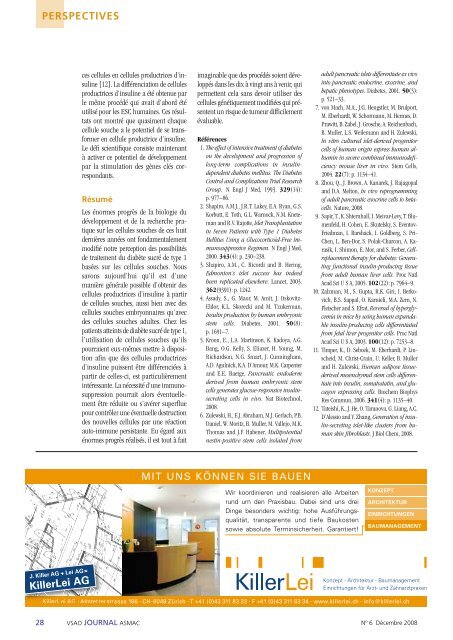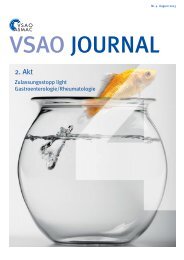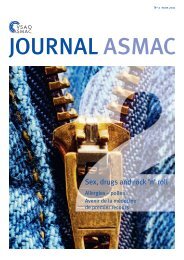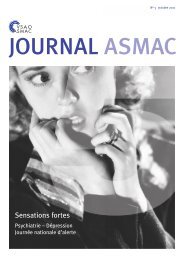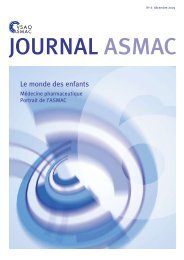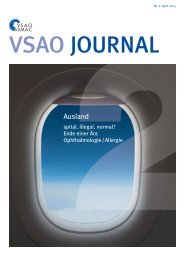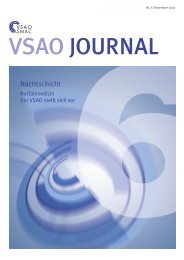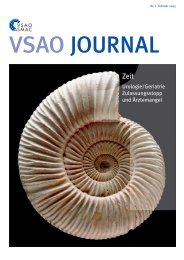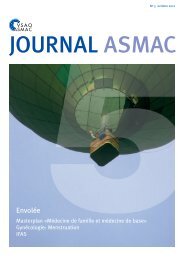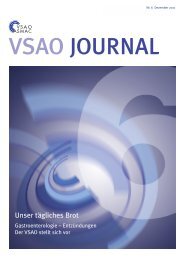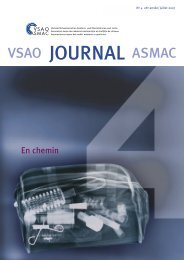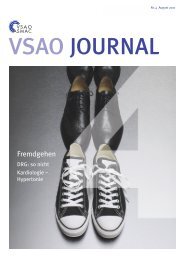Ouvrir le document PDF (5 mb) - VSAO Journal
Ouvrir le document PDF (5 mb) - VSAO Journal
Ouvrir le document PDF (5 mb) - VSAO Journal
You also want an ePaper? Increase the reach of your titles
YUMPU automatically turns print PDFs into web optimized ePapers that Google loves.
PERSPECTIVES<br />
J. Kil<strong>le</strong>r AG + Lei AG=<br />
Kil<strong>le</strong>rLei AG<br />
ces cellu<strong>le</strong>s en cellu<strong>le</strong>s productrices d’insuline<br />
[12]. La différenciation de cellu<strong>le</strong>s<br />
productrices d’insuline a été obtenue par<br />
<strong>le</strong> même procédé qui avait d’abord été<br />
utilisé pour <strong>le</strong>s ESC humaines. Ces résultats<br />
ont montré que quasiment chaque<br />
cellu<strong>le</strong> souche a <strong>le</strong> potentiel de se transformer<br />
en cellu<strong>le</strong> productrice d’insuline.<br />
Le défi scientifique consiste maintenant<br />
à activer ce potentiel de développement<br />
par la stimulation des gènes clés correspondants.<br />
Résumé<br />
Les énormes progrès de la biologie du<br />
développement et de la recherche pratique<br />
sur <strong>le</strong>s cellu<strong>le</strong>s souches de ces huit<br />
dernières années ont fondamenta<strong>le</strong>ment<br />
modifié notre perception des possibilités<br />
de traitement du diabète sucré de type 1<br />
basées sur <strong>le</strong>s cellu<strong>le</strong>s souches. Nous<br />
savons aujourd’hui qu’il est d’une<br />
manière généra<strong>le</strong> possib<strong>le</strong> d’obtenir des<br />
cellu<strong>le</strong>s productrices d’insuline à partir<br />
de cellu<strong>le</strong>s souches, aussi bien avec des<br />
cellu<strong>le</strong>s souches e<strong>mb</strong>ryonnaires qu’avec<br />
des cellu<strong>le</strong>s souches adultes. Chez <strong>le</strong>s<br />
patients atteints de diabète sucré de type 1,<br />
l’utilisation de cellu<strong>le</strong>s souches qu’ils<br />
pourraient eux-mêmes mettre à disposition<br />
afin que des cellu<strong>le</strong>s productrices<br />
d’insuline puissent être différenciées à<br />
partir de cel<strong>le</strong>s-ci, est particulièrement<br />
intéressante. La nécessité d’une immunosuppression<br />
pourrait alors éventuel<strong>le</strong>ment<br />
être réduite ou s’avérer superflue<br />
pour contrô<strong>le</strong>r une éventuel<strong>le</strong> destruction<br />
des nouvel<strong>le</strong>s cellu<strong>le</strong>s par une réaction<br />
auto-immune persistante. Eu égard aux<br />
énormes progrès réalisés, il est tout à fait<br />
28 <strong>VSAO</strong> JOURNAL ASMAC<br />
imaginab<strong>le</strong> que des procédés soient développés<br />
dans <strong>le</strong>s dix à vingt ans à venir, qui<br />
permettent cela sans devoir utiliser des<br />
cellu<strong>le</strong>s génétiquement modifiées qui présentent<br />
un risque de tumeur diffici<strong>le</strong>ment<br />
évaluab<strong>le</strong>.<br />
Références<br />
1. The effect of intensive treatment of diabetes<br />
on the development and progression of<br />
long-term complications in insulindependent<br />
diabetes mellitus. The Diabetes<br />
Control and Complications Trial Research<br />
Group. N Engl J Med, 1993. 329(14):<br />
p. 977–86.<br />
2. Shapiro, A.M.J., J.R.T. Lakey, E.A. Ryan, G.S.<br />
Korbutt, E. Toth, G.L. Warnock, N.M. Kneteman<br />
and R.V. Rajotte, Is<strong>le</strong>t Transplantation<br />
in Seven Patients with Type 1 Diabetes<br />
Mellitus Using a Glucocorticoid-Free Immunosuppressive<br />
Regimen. N Engl J Med,<br />
2000. 343(4): p. 230–238.<br />
3. Shapiro, A.M., C. Ricordi and B. Hering,<br />
Edmonton’s is<strong>le</strong>t success has indeed<br />
been replicated elsewhere. Lancet, 2003.<br />
362(9391): p. 1242.<br />
4. Assady, S., G. Maor, M. Amit, J. Itskovitz-<br />
Eldor, K.L. Skorecki and M. Tzukerman,<br />
Insulin production by human e<strong>mb</strong>ryonic<br />
stem cells. Diabetes, 2001. 50(8):<br />
p. 1691–7.<br />
5. Kroon, E., L.A. Martinson, K. Kadoya, A.G.<br />
Bang, O.G. Kelly, S. Eliazer, H. Young, M.<br />
Richardson, N.G. Smart, J. Cunningham,<br />
A.D. Agulnick, K.A. D’Amour, M.K. Carpenter<br />
and E.E. Baetge, Pancreatic endoderm<br />
derived from human e<strong>mb</strong>ryonic stem<br />
cells generates glucose-responsive insulinsecreting<br />
cells in vivo. Nat Biotechnol,<br />
2008.<br />
6. Zu<strong>le</strong>wski, H., E.J. Abraham, M.J. Gerlach, P.B.<br />
Daniel, W. Moritz, B. Mul<strong>le</strong>r, M. Val<strong>le</strong>jo, M.K.<br />
Thomas and J.F. Habener, Multipotential<br />
nestin-positive stem cells isolated from<br />
MIT UNS KÖNNEN SIE BAUEN<br />
Wir koordinieren und realisieren al<strong>le</strong> Arbeiten<br />
rund um den Praxisbau. Dabei sind uns drei<br />
Dinge besonders wichtig: hohe Ausführungsqualität,<br />
transparente und tiefe Baukosten<br />
sowie absolute Terminsicherheit. Garantiert!<br />
adult pancreatic is<strong>le</strong>ts differentiate ex vivo<br />
into pancreatic endocrine, exocrine, and<br />
hepatic phenotypes. Diabetes, 2001. 50(3):<br />
p. 521–33.<br />
7. von Mach, M.A., J.G. Hengst<strong>le</strong>r, M. Brulport,<br />
M. Eberhardt, W. Schormann, M. Hermes, D.<br />
Prawitt, B. Zabel, J. Grosche, A. Reichenbach,<br />
B. Mul<strong>le</strong>r, L.S. Wei<strong>le</strong>mann and H. Zu<strong>le</strong>wski,<br />
In vitro cultured is<strong>le</strong>t-derived progenitor<br />
cells of human origin express human albumin<br />
in severe co<strong>mb</strong>ined immunodeficiency<br />
mouse liver in vivo. Stem Cells,<br />
2004. 22(7): p. 1134–41.<br />
8. Zhou, Q., J. Brown, A. Kanarek, J. Rajagopal<br />
and D.A. Melton, In vivo reprogramming<br />
of adult pancreatic exocrine cells to betacells.<br />
Nature, 2008.<br />
9. Sapir, T., K. Shternhall, I. Meivar-Levy, T. Blumenfeld,<br />
H. Cohen, E. Skutelsky, S. Eventov-<br />
Friedman, I. Barshack, I. Goldberg, S. Pri-<br />
Chen, L. Ben-Dor, S. Polak-Charcon, A. Karasik,<br />
I. Shimon, E. Mor, and S. Ferber, Cellreplacement<br />
therapy for diabetes: Generating<br />
functional insulin-producing tissue<br />
from adult human liver cells. Proc Natl<br />
Acad Sci U S A, 2005. 102(22): p. 7964–9.<br />
10. Zalzman, M., S. Gupta, R.K. Giri, I. Berkovich,<br />
B.S. Sappal, O. Karnieli, M.A. Zern, N.<br />
F<strong>le</strong>ischer and S. Efrat, Reversal of hyperglycemia<br />
in mice by using human expandab<strong>le</strong><br />
insulin-producing cells differentiated<br />
from fetal liver progenitor cells. Proc Natl<br />
Acad Sci U S A, 2003. 100(12): p. 7253–8.<br />
11. Timper, K., D. Seboek, M. Eberhardt, P. Linscheid,<br />
M. Christ-Crain, U. Kel<strong>le</strong>r, B. Mul<strong>le</strong>r<br />
and H. Zu<strong>le</strong>wski, Human adipose tissuederived<br />
mesenchymal stem cells differentiate<br />
into insulin, somatostatin, and glucagon<br />
expressing cells. Biochem Biophys<br />
Res Commun, 2006. 341(4): p. 1135–40.<br />
12. Tateishi, K., J. He, O. Taranova, G. Liang, A.C.<br />
D’A<strong>le</strong>ssio and Y. Zhang, Generation of insulin-secreting<br />
is<strong>le</strong>t-like clusters from human<br />
skin fibroblasts. J Biol Chem, 2008.<br />
KONZEPT<br />
ARCHITEKTUR<br />
EINRICHTUNGEN<br />
BAUMANAGEMENT<br />
Konzept . Architektur . . . Baumanagement<br />
Einrichtungen für Arzt- und Zahnarztpraxen<br />
Kil<strong>le</strong>rLei AG . Altstetterstrasse 186 . CH-8048 Zürich . T +41 (0)43 311 83 33 . F +41 (0)43 311 83 34 . www.kil<strong>le</strong>r<strong>le</strong>i.ch . info@kil<strong>le</strong>r<strong>le</strong>i.ch<br />
N o 6 Déce<strong>mb</strong>re 2008


